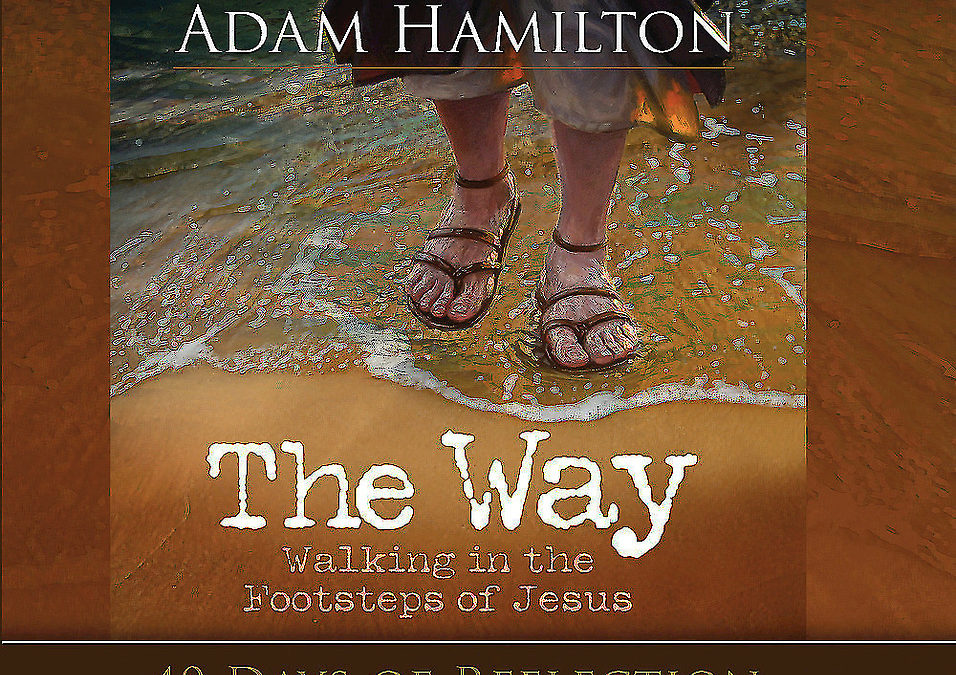The Way: Walking in the Footsteps of Jesus
Adam Hamilton
Review by Landrum P. Leavell III, ThD.
Adam Hamilton was the conversation partner last month at the Orcas Island Advance 2018. It was a pleasure and a joy to meet and spend a couple of days with him and his wife. Leading up to the Advance, I’d read his book on the life of the apostle Paul, titled The Call. (I highly recommend it, too, to truly give you a 30,000 foot vantage point of Paul’s life.) From that book, I learned that Adam likes to travel and has had many ventures to biblical sites through the years where he writes and records videos to aid those who may never get to go themselves.
Through the reading and in personal conversation, I found that he and I share a love of the land of Israel. I think his tally outnumbers mine, but next month I’ll take my sixteenth trip to what is now referred to as “the Promising Land.” Adam, as I, would like everyone to visit this pregnant land. You can never see it all, and they keep finding things! Yet, many will never get to make that pilgrimage. The good news is that Adam has written The Way to share the land with you (there is also a video available to supplement the book).
As one who has traveled there many times, I loved the book. Adam walks you to the Jordan River where Jesus was baptized and to the Judean wilderness where He was tempted. To Capernaum, His base camp during His three years of public ministry. To the Mount of the Beatitudes where He proclaimed the Kingdom, the Sea of Galilee, Jacob’s Well, and on to Jerusalem to recall the last week of Jesus’ life
By his own admission, Adam tries to help the reader “hear familiar stories with fresh ears, drawing upon insights from history, archaeology, and the geography of the Holy Land.” (9) The reader retraces the steps of Jesus across Israel and Palestine. In doing so, Adam fills in many of the gaps, the between-the-lines stories. For example, the backstory of John the cousin/Baptist baptizing Jesus includes the distinct possibility that J.B. spent time in the Qumran monastic community along the shores of the Dead Sea with the Essenes. This is the community that in all likelihood produced and hid the Dead Sea Scrolls. When Jerusalem was destroyed in A.D.70, they probably fled to Masada, leaving the scrolls in jars placed in the caves. Discovered 1,878 years later by a shepherd boy, you can now see them on exhibit!
There are all sorts of parallels and commonalities between the message of Jesus and the teachings of the Essenes, sixty-one according to one source. Leading up to the baptism, Adam walks you through the meaning and use of water for both cleaning and a way of experiencing the cleansing and wholeness that come from God. J.B. had probably left the Qumran community following a time of dedication when he headed to the wilderness near Beth-A-Bara, where the Israelites crossed over from the wilderness, considered the place where Jesus was baptized by His cousin, “preparing the way…” That is what John pointed toward.
Then Adam takes you to and through the wilderness where Jesus was tempted. This wilderness looks today much like it would have in Jesus’ day. After Jesus was rejected in His own hometown, He would have made His way toward Capernaum, near the Sea of Galilee, traveling through the Valley of the Doves near Mount Arbel overlooking the Sea of Galilee. The feelings of loneliness and rejection must have been overwhelming. As He made this journey, Adam notes that “aside from the events of Jesus’ final week, 80 percent of the Gospel stories would take place in the towns that He could see from that vantage point.” (48)
The chapter on Jesus’ healing ministry in Capernaum, the second-most important town in the Gospels is outstanding. Jesus performed more miracles there than anywhere else in the Gospels. Adam writes more than a travel documentary. His insights and pointed applications along the way are poignant. Reminding us that we walk in Christ’s footsteps, Adam says, “We are all called to be healers…. Whose stretcher-bearer are you?” (66)
We are led to and through the mountains, with Jesus proclaiming the Kingdom, the central focus of His teaching and message. Hamilton leads the reader through the Sermon on the Mount under the headings: the Beatitudes, The Mission of God’s People: Beautiful Deeds, Exercises in Remembering the Point, Practicing Acts of Personal Piety, Money, Possessions, and Money, No Judging Others, Do Unto Others, and A Wise Builder.
Jesus loved the Sea of Galilee. Did you know that it is mentioned in the Gospels more than forty times? Some of the most beloved stories from Jesus’ ministry occurred there. The disciples were called there, the sea (lake) was calmed there, and Jesus walked on it.
In the chapter on Samaria, we see Jesus’ affinity for sinners, outcasts, and the poor. He was interested in those that others put down. Adam beautifully treats each of these categories of people, the am ha-aretz, a Hebrew phrase often used in Jesus’ time to indicate outsiders of one kind or another.
The chapter on Jerusalem focuses on Jesus’ final week, walking you through the events and places of Passion Week—the Mount of Olives, the Kidron Valley, the Garden of Gethsemane, the Temple—cleansing and confrontations, the Upper Room and the Last Supper, and the cross.
Hamilton concludes with an epilogue noting that Friday was not the end of the story, and he asks what our defining story is….
After going to Israel, many describe it as transitioning from reading the Bible in black-and-white to reading it in 3-D. There is a lot of truth to that. I highly recommend this book, for it you never get to make the pilgrimage yourself, Adam Hamilton will usher you into 2-D!
You’re welcome.

